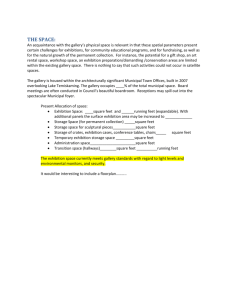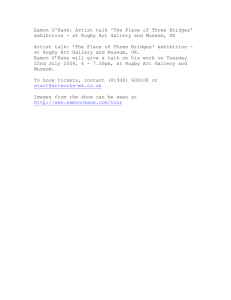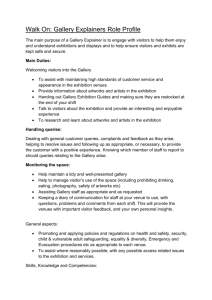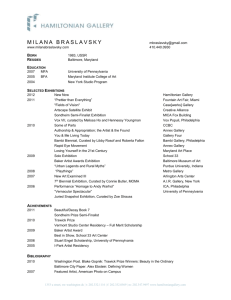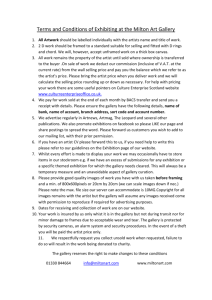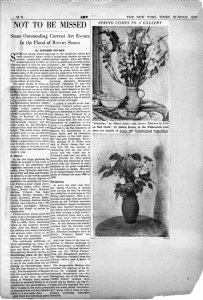Education Guide Panto Collapsar by Mikala Dwyer
advertisement
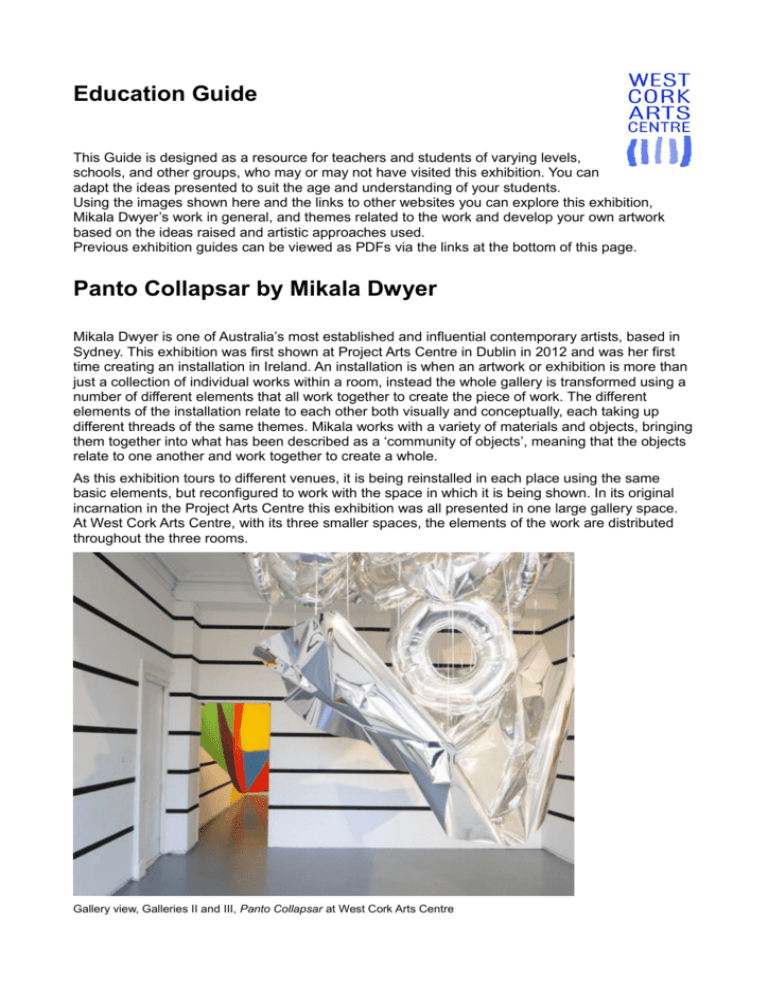
Education Guide This Guide is designed as a resource for teachers and students of varying levels, schools, and other groups, who may or may not have visited this exhibition. You can adapt the ideas presented to suit the age and understanding of your students. Using the images shown here and the links to other websites you can explore this exhibition, Mikala Dwyer’s work in general, and themes related to the work and develop your own artwork based on the ideas raised and artistic approaches used. Previous exhibition guides can be viewed as PDFs via the links at the bottom of this page. Panto Collapsar by Mikala Dwyer Mikala Dwyer is one of Australia’s most established and influential contemporary artists, based in Sydney. This exhibition was first shown at Project Arts Centre in Dublin in 2012 and was her first time creating an installation in Ireland. An installation is when an artwork or exhibition is more than just a collection of individual works within a room, instead the whole gallery is transformed using a number of different elements that all work together to create the piece of work. The different elements of the installation relate to each other both visually and conceptually, each taking up different threads of the same themes. Mikala works with a variety of materials and objects, bringing them together into what has been described as a ‘community of objects’, meaning that the objects relate to one another and work together to create a whole. As this exhibition tours to different venues, it is being reinstalled in each place using the same basic elements, but reconfigured to work with the space in which it is being shown. In its original incarnation in the Project Arts Centre this exhibition was all presented in one large gallery space. At West Cork Arts Centre, with its three smaller spaces, the elements of the work are distributed throughout the three rooms. Gallery view, Galleries II and III, Panto Collapsar at West Cork Arts Centre This exhibition is both a continuation of Mikala’s ongoing interests (in the occult, the natural world, science, maths, materials, objects, and space) and a response to Ireland (its heritage, culture and current economic situation). The title of the exhibition, Panto Collapsar, brings together two ideas, Panto suggesting a sense of theatre, comedy and audience participation (a pantomime) and Collapsar , a term used to describe the movement of a collapsed star into a black hole, an impending collapse. For this exhibition Mikala was particularly interested in exploring gold as a material. I wanted to do something with gold and started with the idea of a kind of reverse alchemy—turning a precious material back into base matter. It was a play on gold’s recent economic power: As you watch the price of gold going up, you can sometimes see economies going down. Mikala Dwyer interviewed in Artforum Alchemy was an early form of science that led eventually to chemistry and medicine, one of the aims of alchemists was to try and turn base metals like iron into gold. Mikala’s work aims for the opposite, turning this highly valued, precious metal from the stars, back into a base material. The gold in this exhibition is not real gold, it is not shining, it is a rough approximation of gold - gold paint, metallic fabrics. This celestial material has become an object of commerce, an abstract notion of numbers and worth, but in returning it to its place as a physical material, the artist is also re-imagining its magic. Science, maths and geometry play important roles in Mikala’s work. She is fascinated by the physical world, and the sciences that help us to understand it. Science and maths and stuff are really magical as well, and the sort of material universe is extremely unbelieveable Mikala Dwyer talking about her exhibition at Project Arts Centre Gallery I The Additions and the Subtractions, 2012 Mixed media including Marlboro gold cigarettes, distilled spirits, gold paint, copper coins, spirit level, short stem glasses and clay ashtrays. Gallery I hosts a group of objects on plinths called The Additions and the Subtractions. The artist has made collections of objects like these, a number of times for different exhibitions, and including different objects and materials in different combinations, often using this same title. The plinths are arranged around the room, in an elliptical shape, leaving an empty space in the center, like a stone circle, standing quietly marking out a space, or as if the objects themselves are holding a séance. There’s an organizational aspect to the occult that I don’t find in other things. Tarot cards, palm readings, and séances are all kinds of tools; they articulate or frame voids, and what occurs in those voids keeps me on edge —they offer the poetic possibility that just maybe something will appear. Mikala Dwyer interviewed in Artforum The title suggests maths, or accounting, adding and taking away, and that the circle of objects is more than a sum of its parts. There are many references and meanings hidden amongst these objects. The objects themselves include everyday objects, many of which reflect Ireland’s pub culture, including bottles of whiskey, glasses, coins, clay ashtrays and cigarettes. Many of the objects reference gold in some way, such as the whiskey’s golden liquid and the Marlboro gold cigarettes. The whiskey and spirit level also suggest puns on the ‘spirits’ this séance may be trying to evoke. These ‘golden’ objects are teamed with rough clay, coins, semi precious stones and the plinths on which they stand are painted in bronze, silver and gold colours. The clay numbers suggest numerology, and the superstition and meaning we give to certain numbers. The plastic ‘bubbles’ both define empty spaces, and act as windows that distort the world. A projected light onto a hinged panel allows visitors to angle light around the circle of objects, referencing Newgrange and stone circles, designed to capture the solstice sun. The Additions and the Subtractions, 2012. Mixed media including Marlboro gold cigarettes, distilled spirits, gold paint, copper coins, spirit level, short stem glasses and clay ashtrays. Placing something on a plinth raises its importance, it brings it up to eye level and says; here is something to look at, something worthwhile. The artist is interested in these inanimate objects as carriers for meaning:the way people have objects in their homes, they are magical things, they become these carriers for so much… fluid carriers of emotion, or spirit, or whatever you want to call it …. Like when someone dies and everything becomes a holy relic Mikala Dwyer talking about her exhibition at Project Arts Centre We place objects in our home in special places, to give the object importance in the same way, on the mantelpiece, or a shelf, to remind us of a time, or place, or person. The artist is giving these objects value and placing them in a sacred circle to see what may happen. When Dwyer brings objects, artefacts and materials together in a group formation, it is as though she’s asking them to speak together of the future and of the unknown – as the artist puts it: to ‘shore themselves up against everything they’ve lost.’ from Tessa Gibiln's Curator's notes on the exhibition at Project Arts Centre Gallery II The Silvering, 2012. Mylar, silver foil balloons, helium The Silvering floats in Gallery II, made of sliver helium balloons and mylar, a type of reflective polyester film. Installation work such as this is often interested in using the space of the gallery in different ways. Where The Additions and the Subtractions takes a circular formation enclosing an empty space in the centre of the room, The Silvering creates a floating ceiling that moves about the gallery inhabiting the space, and also dividing it into above and below. The balloons themselves enclose spaces containing nothing, or apparently nothing - only invisible gases, and take the form of circles or rings, like ‘O’s or zeroes, a recurrent shape in the artist's work. This work refers to the Maori myth of creation, from the artist’s native Australia, in which the sky father and earth mother embrace. I’ve always been interested in exploring an “extra space,” something between two traditional spaces, like an extra dimension or an extra language.’ Mikala Dwyer interviewed in Artforum The Collapzars, 2012. Various fabrics, gold paint, plastics, plaster Accompanying The Silvering in Gallery II is The Collapzars, four shapes that suggest puppet-like figures, or costumes, with large misshapen golden masks for heads, the circular hole, echoing the circular balloons, enclosing empty space, and gold material hanging beneath like robes. Their title suggests they are perhaps born from a collapsing star, or the meeting of sky and earth that The Silvering references, the moment of creation, the big bang. It started with just this thing of thinking about gold, and collapsing stars, and outer space and spirits and trying to find a way to re-imagine gold rather than this thing of commerce, to try and look at it again as a magical substance that comes from exploding stars. Mikala Dwyer talking about her exhibition at Project Arts Centre As a material ,gold suggests both current economic value, with the subject of the economy being a very relevant topic within Ireland at the moment, and its' archaeological and cosmological history. Gold has recently been reported to have its origins in outer space, having been introduced to our planet through meteorite impacts 4 billion years ago. It has literally come from exploding stars, as has all life on this planet. The press information for this exhibition aptly borrows a quote from the song Woodstock by Joni Mitchell; we are stardust (billion year old carbon), we are golden Perhaps The Collapzars are, in fact, us. Gallery III Open Corner, 2012. Wall painting Open Corner is a wall painting recreated for West Cork Arts Centre, based on the original version at Project Arts Centre. This new version introduces two new colours. The painting uses geometrical shapes, including the circular motif found throughout the show, and is reminiscent of an exploding star. The painting was inspired by a visit to an exhibition at the National Library in Dublin, The life and work of WB Yeats, where the artist saw drawings relating to WB Yeat's involvement with the occult society The Hermetic Order of the Golden Dawn. The drawing has an almost threatening, imposing feel to it, dominating the small, enclosed space of Gallery III. This reflects the quite threatening feel that the occult can often produce. The black lines from the drawing extend throughout all three rooms of the gallery, and can be seen as a baseline for the exhibition, drawing all the spaces together and linking them. Further discussion and research Think about everyday objects that have meaning to you, perhaps objects that represent or symbolize something important in your life or objects that have personal meaning to you. Are there specific objects that you keep in a special place, to show their importance, such as on the mantelpiece? Discuss the objects in Mikala Dwyer’s installation, in particular The Additions and the Subtractions, and meanings they might have or suggest to you. Research more about the scientific and historical references from the exhibition; the history of the occult in Ireland, WB Yeats drawings and the Hermetic Order of the Golden Dawn, the origins of gold, and its' archaeological history within Ireland, astronomy and collapsing stars, numerology, stone circles, Newgrange, the solstice, Maori mythology and more. This exhibition is created in response to working in Ireland and uses particular materials and objects with particular resonance because of that. This is known as site-specific artwork – working in response to the place where the work is shown (although often the term is used more specifically for work created outside of a gallery). Consider the area where you live, or a particular place in your area, what associations can you make with this place? What materials does it have connections with? What objects might be relevant to it? To take an example from within West Cork, Allihies has a history of copper mining in the area and therefore copper would be a relevant material. Explore other artists who work with a response to place, or using installation, or exploring themes around magic, science and materials, Joseph Beuys, Ann Hamilton, Olafur Eliasson, or other Australian artists. The Additions and the Subtractions, 2012. Mixed media including Marlboro gold cigarettes, distilled spirits, gold paint, copper coins, spirit level, short stem glasses and clay ashtrays. Practical ideas The following suggestions will give you some ideas of things you can try out for yourself, inspired by Mikala Dwyer’s work. Consider different materials and the qualities of them – rough, shiny, etc Create a collage, using actual materials (tin foil, brown paper, sand paper, sweet wrappers etc) or magazine images of materials (pictures of rock, metal, wood etc), assemble the different materials in different compositions to see how work with (or talk to) each other. Take this a stage further into three dimensions, or installation, by placing found objects and materials together in a space and setting up ‘conversations’ between them. You may want to use objects/materials that have special meaning to you, or are related to each other through their connection to a place or an idea. Think about the relationship between the objects and the arrangement in which you place them. You can make a record of this by photographing it, or drawing or painting the arrangement like a still life. Explore working with gold, silver or other metallic colours in different ways. You can use metallic paints, fabrics, papers or glitter, or objects that have those colours in them. Look at the drawings which inspired Open Corner (see links above), and try creating geometric drawings yourself inspired by them. Use flat primary and secondary colours, with gouache or acrylic paint. Interlock geometric shapes like circles, triangles, squares and curves, then paint in each plane in different colours to create a design. Choose a colour or a material to explore as a starting point. In the same way that Mikala began with thinking about gold, you might decide to explore one colour like red, or blue, or one material like wood, or stone. Brainstorm to come up with as many associations as you can for the colour or material. These associations may be literal, symbolic, scientific, personal, historical, or incidental. Collect pictures and objects that reference your starting point and its associations and use them to create either a collage or a sculptural group. Experiment with organising them in different ways. Try and include as many different meanings and ideas as you can. You could also use these to develop into a painting or drawing, or perhaps you have a table in the corner of your classroom or workspace where you can set up a mini installation. Alison Cronin West Cork Arts Centre www.westcorkartscentre.com
